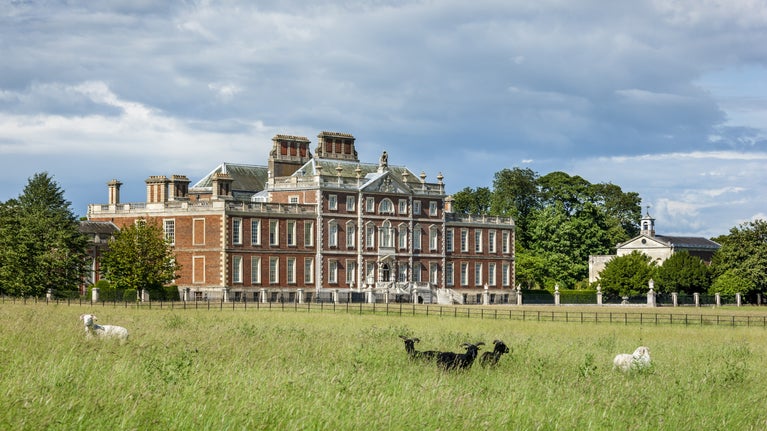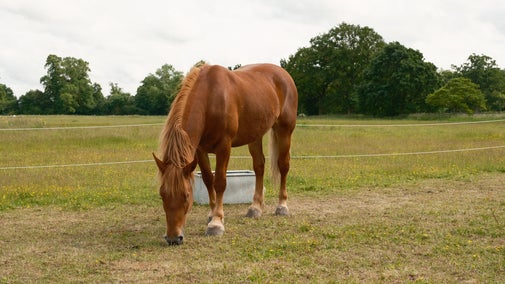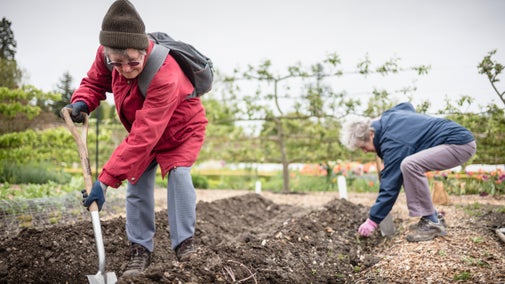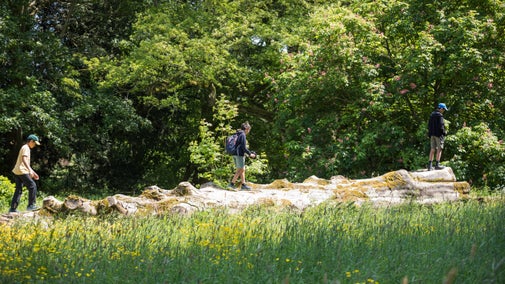
Discover more at Wimpole Estate
Find out when Wimpole Estate is open, how to get here, the things to see and do and more.

Take a trip to the heart of Wimpole Estate with a visit to the historic parkland. Steeped in natural beauty, discover sweeping views across the grounds and explore the variety of habitats, home to thousands of species, all while taking in the fresh country air. With over 500 acres of wide-open space to enjoy, and miles of dedicated accessible pathways, Wimpole’s parkland is the ideal place to reconnect with the natural world. From Lancelot ‘Capability’ Brown to the parkland’s current rare breed residents, many have left their mark on this beautiful corner of south Cambridgeshire.
The National Trust manages 12km of paths in the parkland which will take you to the southern tip of our iconic 4km South Avenue to the Gothic Folly north of the Serpentine lakes. You are free to roam over 500 acres of the parkland and there are paths suitable for a wide range of preferences and abilities. If you are visiting with a dog then please visit our dogs page to make sure you make the most of the day.
Deepen your connection with the parkland and surrounding countryside by joining our volunteer guides on a Wednesday Walk every Wednesday morning, or you can join them for a history themed Sunday Stroll around Wimpole Estate every Sunday morning.
Since March 2024, the Wimpole Estate farm team has recorded 36 incidents of dogs being off lead around livestock, particularly sheep. Sadly, sheep have died in both 2024 and 2025 as a result of injuries caused by dogs, and there have also been multiple incidents of dogs loose among cattle. To protect animal welfare and keep everyone safe, dogs must be kept on leads and under close control near livestock at all times. If you are concerned about the welfare of any of our animals, please contact us on 01223206000.

On your visit to Wimpole, look out for the Gothic Tower. Designed to look like a picturesque medieval ruin, it is based on a sketch by the architect Sanderson Miller in 1749 for his patron, Lord Hardwicke, the owner of Wimpole. The design was later realised in an amended form under the supervision of the great landscape designer Lancelot ‘Capability’ Brown from 1768-72.
In the following centuries, the ruin suffered extensive and gradual damage and access to the Tower and landscape was almost impossible. The conservation of the Tower called for repair of the structure, stabilization of the stonework and reinstatement of missing components of the building, all while preserving the weathered beauty and original ‘ruined’ appearance.
This work was completed as part of an award-winning restoration project in In 2016.
When you visit Wimpole, you can explore ‘Capability’ Brown’s North Park. One of the most beautiful elements of the landscape at Wimpole, at its heart is an extraordinary folly in the form of a ruined castle. The landscape in the North park you see today was created from 1767 for Philip Yorke, 2nd Earl of Hardwicke and his wife Jemima, Marchioness Grey.
When Brown surveyed Wimpole in 1769, he transfigured a vast area of farmland criss-crossed by hedges and roads north of the house. The old formal avenues were thinned or felled, and trees planted singly and in clumps to create open parkland.
Two angular 17th-century fishponds were made into serpentine lakes, and a third new lake was dug to the east. From higher ground these appear to flow through the park, like a sinuous river.
The parkland has a rich diversity of habitats including rivers, lakes, ponds, pastures and meadows all forming a wide range of habitats for wildlife, flora and fauna. Home to thousands of species, our extensive organic farming practices are an essential part of managing these areas. Discover blooming wildflowers at the folly in the spring, or fluttering butterflies on the south avenue in summer. As the leaves on the veteran trees turn brown, find a diverse range of fungi across the estate, and come winter enjoy the peace and stillness of the air while most of the natural world shelters from the colder weather. Please remember whatever the time of year you are visiting to adhere to the countryside code.
Farmland and the rare-breed residents
Of the 2500 acres on the Estate the vast majority is farmland and almost all of this is organically farmed by the National Trust. Our livestock play an essential role in the sustainable conservation and management of the parkland and the natural habitats within it. Cattle and sheep are naturally inquisitive animals, in order to keep you and the animals safe in the fields which they graze, please follow this advice:
Do...
Stop, look and listen on entering a field. Every field with livestock in at Wimpole will have a sign on the gates making you aware if there are cattle and sheep in that field
If possible, walk around the herd. Try to avoid getting between the herd, especially cows and their calves. If cattle react to your presence, move quietly and calmly away from them
Keep your dog close, on a short lead, and under effective control in any field with livestock in
Close the gate behind you when walking through fields containing livestock. Keep us informed of any problems you experience
Don’t...
Hang onto your dog if you feel threatened by cattle - let it go as the cattle are more likely to chase the dog and not you
Put yourself at risk by walking close to cattle
Panic or run – most cattle will stop before they reach you, if they follow just walk away quietly
Sheep and lambs
You may see sheep and lambs in the parkland, please give them plenty of space. Don’t pick up the lambs, even if they are on their own. Ewes will often leave a lamb while she grazes, but the team check them regularly each day to monitor any problems.
Even the friendliest dogs can be unpredictable, dogs approaching sheep can worry them and this can result in livestock injuries and fatalities, so, please always keep them on leads around livestock.

Explore Wimpole's multi-use trail
Wimpole's multi-user trail provides an off-road circular route around the estate, providing even more opportunities to explore the woodland, parkland and farmland. The trail is 5.5 miles, or 8.5 kilometres long.
The trail is multi-use, intended for walkers, runners, cyclists and adapted wheelchair users. It's great for families looking for an easy, safe route that can get them active and enjoying time outside together.
Wimpole is one of ten National Trust properties chosen to build new multi-user trails to encourage visitors to enjoy different activities. The all-weather surface also means more people can explore the estate whatever the season.
Download a PDF of the route map or follow the waymarked signs from the visitor car park.
Cycling at Wimpole
With three routes ranging from one and a half to just over four miles to choose from, there’s something for all ages at Wimpole.
Carriage drive to Arrington
Ideal for beginners, this one and a half mile of tarmac terrain is ideal for mini explorers. Look out for the grand Arrington gates and the South Avenue.
Victoria Drive
This woodland track is just over three miles long. Enjoy a gentle route, which follows the estate road and a crossing, but is mainly on a dirt track through to Cobbs Wood. Please be aware that this route can get muddy.
Mare Way Challenge
Covering over four miles, and takes you on woodland track, arable fields and bridleways and the fun of a good challenge. You can even ride to Wimpole along the Wimpole Way.
Our woodland belts benefit from national and European protection, thanks to their population of rare Barbastelle bats. In fact, we have one of the very few Barbastelle maternity roosts in the UK, in a block of woodland within the Parkland.
To help look after these rare and elusive creatures, tree management needs to be limited in the future, so that holes and cracks in older trees can provide roosting sites. There are at least 80 trees that are classed as dangerous within our Tree Safety Management Policy.
While we cannot work on these trees we have reduced public access to this sensitive area, re-routing a section of path to minimise disturbance and help these roosting sites establish. We’re working closely with our partners to establish our next steps. Natural England continue to advise us on the management of our woodland belts, which are a designated Special Area of Conservation.
Our multi-use trail is an all-weather, accessible alternative to explore the wider parkland here at Wimpole. The trail takes in an 8 km (5.5 mile) circular route around the estate, and is suitable for walkers, runners, cyclists, and adapted wheelchair users.
We’re passionate about providing opportunities for people to get outdoors and closer to nature. Our aim is to make access to the parkland as easy as possible and help people feel comfortable about heading off into the countryside. However, it’s a careful balancing act of enabling access and safeguarding nature. We’re continuing to review the closure of the woodland belts, and whilst this important work takes place, we encourage visitors to explore the wider estate, of which there are 26km of alternative paths and walking trails to choose from.
The commemorative tree scheme is a popular way to commemorate a special person or occasion. The tree planting has now been completed but you can purchase a tree that has already been planted.
The trees are being planted in the parkland following historical evidence to replace veteran trees. Species include oak, lime, horse chestnut, hornbeam, field maple, beech, walnut, London plane, sycamore, thorn.
The cost to plant a commemorative tree is £300. This price includes a metal cattle proof tree guard and any subsequent maintenance (weeding, mulching) or a replacement if the tree dies.
We maintain a record of all commemorative trees, consisting of a certificate with wording requested by the donor and a map of the tree location.
If you wish to purchase a commemorative tree, please email the estate office for further information.

Find out when Wimpole Estate is open, how to get here, the things to see and do and more.
Download a map of the Multi-use trail route.
Built in 1794, Home Farm is the only in-hand farm of its kind in the National Trust. Unique to Wimpole Estate, it is a model for sustainable farming practices. A must see on your next visit, it is home to many rare-breed animals and the species of flora and fauna that make the estate an agricultural champion.

Take a look at some of the important work that takes place at Wimpole Estate on a day-to-day basis, to look after this special place for everyone, for ever.

Discover how Wimpole is using the Green Recovery Fund to help create and restore habitats, support solutions to tackle climate change and connect people with nature.
From events and activities to getting close to animals, here's what you need to know about a family day out at Wimpole.

Plan a visit to one of the special countryside places in our care and discover the benefits of being in the great outdoors. Pack your walking boots and get ready to explore woodlands, valleys and rivers.

Explore some of the finest landscapes in our care on coastal paths, accessible trails, woodland walks and everything in between. Find the best places to walk near you.

With distinctive fenland landscapes, grand houses and lush farmland, discover all there is to see at National Trust places in Cambridgeshire, in East Anglia.
